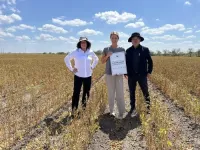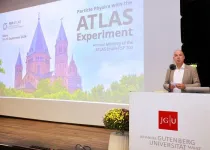(Press-News.org) A series of case reports to be presented at this year’s Annual Meeting of The European Association for the Study of Diabetes (EASD), Madrid (9-13 Sept), describe how a technology giving insulin doses informed by an insulin pump algorithm helped three adults with type 1 diabetes better manage their blood sugars enabling them to lead more active lives, and even run marathons.
The AID system contains an advanced hybrid closed loop algorithm that automates the delivery of both basal and correction bolus insulin every 5 minutes based on sensor glucose values.
“It is great to see advances in diabetes technology come to fruition and deliver such improvements to people’s lives,” said lead author Dr Maria Onetto from Pontificia Universidad Católica Chile, Santiago, Chile. “This technology is game changing, allowing more people with diabetes to have safer, healthier, more active lives.”
In T1D, a person's blood glucose level becomes too high (hyperglycaemia) because there is no, production of insulin by the pancreas. Blood glucose levels can only be regulated by giving insulin to prevent hyperglycaemia.
If T1D is not well controlled, people are at increased risk of long-term complications of hyperglycaemia, including microvascular damage such as eye, kidney or nerve damage, heart disease or stroke.
“Despite better systems for monitoring blood sugars and delivering insulin, maintaining glucose levels in target range during aerobic training and athletic competition is especially difficult,” explained Dr Onetto. “The use of automated insulin delivery technology is increasing, but exercise continues to be a challenge for individuals with T1D, who can still struggle to reach the recommended blood sugar targets.”
Although there are some published recommendations of how to adjust insulin delivery and carbohydrate intake for exercise, there are few reports of real-world examples of people with T1D using automated insulin delivery systems during intensive exercise or competition.
The technology known as Advance-Hybrid Closed-Loop consists of an algorithm on an insulin pump which communicates with the traditional continuous glucose monitoring. The real-time glucose monitoring system adjusts insulin doses every 5 minutes according to blood sugar levels, meaning that it continuously responds to the persistent changes in blood sugar levels.
The patient delivers boluses for meals and snacks by entering the total grams of carbohydrates they are consuming. The algorithm targets a glucose level chosen by the user, which can be adjusted to be 100, 110 or 120 mg/dL. The patient can also set a temporary sensor glucose target (Temp Target) of 150 mg/dL for situations where hypoglycaemia risk may be increased, such as during exercise. When the Temp Target is on, auto-bolus corrections are disabled.
To assess blood sugar control during the marathons, the researchers measured: time in range (TIR) that shows the percentage of time a person spends within a target glucose range (3.9 to 10 mmol/litre); time below range (TBR; below 70 mg/dL or 3.9 mmol/litre) target to less than 4% of the time; and time above range (TAR) when blood glucose levels exceed 180 mg/dL.
50-year-old man with T1D for 22 years ran Tokyo marathon in around 3.5 hours
The first report details a 50-year-old man who had been living with T1D for 22 years before he ran the Tokyo Marathon in March 2023 in 3 hours and 34 minutes.
Thirty days before the race his time in the target glucose range (TIR 70-180 mg/dL ) was 89%, time above range (TAR>180 mg/dL) was 9%, time below range (TBR<70 mg/dL) was 1%, and HbA1c (average blood sugar over the last 8 to 12 weeks) was 6.9%.
In order to prevent hypoglycaemia, on the morning of the marathon he reduced his breakfast insulin dose by 25% and the insulin dose applied to the pre-race snack was also reduced by 50% to better manage blood sugar levels.
He consumed glucose gels, the primary source of carbohydrates during the race, at a rate of 0.39 g/kg/hour, with 102g consumed overall.
During the race, the man maintained excellent glycaemic control, spending 96% of the marathon within the correct glucose range, just 4% below range, and no time above the target range. He achieved an average blood glucose of 107mg/dl—well below the mean glucose of less than 154 mg/dl recommended in adults (see table in abstract).
40-year-old man with T1D for 4 years ran Santiago marathon in under 5 hours
The second report is of a 40-year-old man who had been living with T1D for the past four years. He took part in the Santiago (Chile) marathon in May 2023, completing the race in 4 hours and 56 minutes.
Before the marathon (30 days), his time in the target glucose range was 76%, time above range was 9%, time below range was 3%, and HbA1c was 6.7%.
The day of the race, he did not lower his breakfast insulin dose, but he reduced the insulin dose applied to the pre-race snack by 100%. During the marathon, the man consumed glucose gels at a rate of 0.42 g/kg/hour, with 120g consumed in total.
The man spent 100% of the marathon within the correct glucose range with an average blood glucose of 110mg/dl, underscoring the capability of the glucose monitoring system to respond in real time (see table in abstract).
34-year-old woman with T1D for 27 years ran Paris marathon in under 4 hours
The third report describes a 34-year-old woman who had been living with T1D for 27 years before she completed the Paris Marathon in April 2023 in 3 hours and 56 minutes.
Thirty days before the marathon, her time in the target glucose range was 83%, time above range was 15%, time below range was 1%, and her HbA1c was 6.6%.
On the morning of the marathon, she did not lower her breakfast insulin dose, but she reduced the insulin dose applied to her pre-race snack by 83%.
During the marathon, she consumed glucose gels at a rate of 0.5 g/kg/hour, with 115g consumed in total. She spent the whole marathon well above the target glucose range, with an average blood glucose of 271mg/dl—well above the mean glucose of less than 154 mg/dl recommended in adults.
As Dr Onetto explained: “It is likely that the woman remained hyperglycaemic throughout the race for a number of reasons. She may have eaten too many carbs before the race without insulin, but she also didn’t deactivate the temporary sensor glucose target (temp target) because she hadn’t realised that disconnecting it would re-enable the auto-correction boluses.”
She added, “We hope these case studies provide insights for healthcare professionals who assist athletes with type 1 diabetes using automated insulin delivery systems during intense physical activities. Underscoring the importance of specialised education, planning, and personalised approaches, this research emphasises the substantial opportunities that automated insulin delivery technology offers to individuals with type 1 diabetes, enabling them to lead active lives.”
END
New technology ‘game changing’ for marathon runners with type 1 diabetes
Case reports of three adults with type 1 diabetes describe how hybrid closed-loop technology – that gives insulin doses informed by an integrated insulin pump algorithm – enabled them to run marathons in Tokyo, Santiago, and Paris
2024-09-12
ELSE PRESS RELEASES FROM THIS DATE:
Vitis vinifera and muscadines: Grape breeders seek the best of both grapes
2024-09-12
By John Lovett
Arkansas Agricultural Experiment Station
FAYETTEVILLE, Ark. — Muscadines may be the folksy American of the grape world, but they have many qualities like disease resistance and unique flavors that are desired in the more popular Vitis vinifera (bunch grapes) species.
Likewise, Vitis vinifera — the species that most people eat as table grapes and drink in wine — has many characteristics desirable for muscadines, like thinner skin, a crispier texture and seedlessness. Successfully combining traits from these two species of grapes is a challenge due to differing numbers ...
A new tack for slack: motivate workers
2024-09-12
Workplace communications platforms such as Slack and Microsoft Teams are sometimes accused of reducing productivity by distracting workers with constant messages and the need to respond to them.
But new research by Wen Wen, associate professor of information, risk, and operations management (IROM) at Texas McCombs, shows that companies can use them to do the opposite: to motivate workers.
How? By praising successful employees in all-staff channels that everyone can see — especially when they can’t see one another face-to-face.
“One important challenge faced by many companies is how to motivate remote workers and keep them productive,” ...
UTA harvests first climate-smart soybean crop
2024-09-12
UT Arlington biologists, working with underserved farmers in South Texas, have harvested their first crop of climate-smart soybeans. This harvest is part of a four-and-a-half-year, $5 million project funded by the U.S. Department of Agriculture (USDA) to test whether climate-smart agricultural practices can reduce emissions of greenhouse gases (GHGs) responsible for climate change—including carbon dioxide, methane, and nitrous oxide—while simultaneously increasing crop production.
“We ...
JGU hosts annual meeting of the ATLAS Collaborative Research Center
2024-09-12
The connections between particles and their mass, the composition of the universe out of matter and antimatter and the search for previously unknown particles such as the so-called “dark matter” are the focus of researchers at the research center CERN in Geneva, which is celebrating its 70th birthday this year with events all around the world. In four large-scale experiments, scientists at the Large Hadron Collider (LHC) are getting to the bottom of the secrets of the universe. This particle accelerator offers researchers ...
Med school scientist receives prestigious NSF award for inflammation research
2024-09-12
Associate Professor Justine Tigno-Aranjuez will use a five-year grant of more than $1 million to study how influences on the production of lipid mediators to better understand impacts on inflammation.
A College of Medicine researcher has received a prestigious U.S. National Science Foundation CAREER Award to support her research into the cellular causes of inflammation, discoveries that could be pivotal for treating conditions like Crohn’s disease and arthritis.
Justine Tigno-Aranjuez’s lab has been researching lipid mediators — ...
Uptick in drug overdose rates is widely reported especially among young women
2024-09-12
Overdose rates in Colombia involving illegal opioids, hallucinogens, stimulants and sedative psychotropic medication increased greatly during 2018-2021, mainly caused by overdoses in young women, according to a study at Columbia University Mailman School of Public Health. Drug overdoses increased by 356 percent from 8.5 to 40.5 percent per 100,000 individuals from 2010 to 2021. The findings are published in the American Journal of Public Health.
The study is the first to describe national ...
Understanding what helps families with teens maintain household vaping bans
2024-09-12
UNIVERSITY PARK, Pa. — In the roughly 20 years since e-cigarettes were introduced in the United States, use among young people has grown substantially. By 2022, more than one in five high school seniors reported they had vaped nicotine in the past month.
Household smoking bans — rules against anybody smoking inside a home — are an effective tool for delaying or preventing teen cigarette smoking, according to Jennifer Maggs, professor of human development and family studies at Penn State, and her collaborators, so they examined if the same might hold true for vaping. They assessed how many households with teenage children in the ...
Can AI talk us out of conspiracy theories?
2024-09-12
Have you ever tried to convince a conspiracy theorist that the moon landing wasn’t staged? You likely didn’t succeed, but ChatGPT might have better luck, according to research by MIT Sloan School of Management professor David Rand and American University professor of psychology Thomas Costello, who conducted the research during his postdoctoral position at MIT Sloan.
In a new paper “Durably reducing conspiracy beliefs through dialogues with AI” published in Science, the researchers show that large language models can effectively reduce ...
‘Even the deepest of rabbit holes may have an exit’
2024-09-12
Embargoed: Not for Release Until 2:00 pm U.S. Eastern Time Thursday, 12 September 2024
‘Even the deepest of rabbit holes may have an exit’
Pathbreaking psychology study reveals conversations with AI models can reduce conspiracy theory beliefs
(WASHINGTON, D.C.) Sept. 12, 2024 – ‘They’re so far down the rabbit hole of conspiracy theories that they’re lost for good’ is common thinking when it comes to conspiracy theorists. This generally accepted notion is now crumbling.
In a pathbreaking research study, a team of researchers from American University, ...
An exit for even the deepest rabbit holes: Personalized conversations with chatbot reduce belief in conspiracy theories
2024-09-12
Personalized conversations with a trained artificial intelligence (AI) chatbot can reduce belief in conspiracy theories – even in the most obdurate individuals – according to a new study. The findings, which challenge the idea that such beliefs are impervious to change, point to a new tool for combating misinformation. “It has become almost a truism that people ‘down the rabbit hole’ of conspiracy belief are almost impossible to reach,” write the authors. “In contrast to this pessimistic view, we [show] that a relatively brief conversation with a generative AI model can produce ...
LAST 30 PRESS RELEASES:
Numbers in our sights affect how we perceive space
SIMJ announces global collaborative book project in commemoration of its 75th anniversary
Air pollution exposure and birth weight
Obstructive sleep apnea risk and mental health conditions among older adults
How talking slows eye movements behind the wheel
The Ceramic Society of Japan’s Oxoate Ceramics Research Association launches new international book project
Heart-brain connection: international study reveals the role of the vagus nerve in keeping the heart young
Researchers identify Rb1 as a predictive biomarker for a new therapeutic strategy in some breast cancers
Survey reveals ethical gaps slowing AI adoption in pediatric surgery
Stimulant ADHD medications work differently than thought
AI overestimates how smart people are, according to HSE economists
HSE researchers create genome-wide map of quadruplexes
Scientists boost cell "powerhouses" to burn more calories
Automatic label checking: The missing step in making reliable medical AI
Low daily alcohol intake linked to 50% heightened mouth cancer risk in India
American Meteorological Society announces Rick Spinrad as 2026 President-Elect
Biomass-based carbon capture spotlighted in newly released global climate webinar recording
Illuminating invisible nano pollutants: advanced bioimaging tracks the full journey of emerging nanoscale contaminants in living systems
How does age affect recovery from spinal cord injury?
Novel AI tool offers prognosis for patients with head and neck cancer
Fathers’ microplastic exposure tied to their children’s metabolic problems
Research validates laboratory model for studying high-grade serous ovarian cancer
SIR 2026 delivers transformative breakthroughs in minimally invasive medicine to improve patient care
Stem Cell Reports most downloaded papers of 2025 highlight the breadth and impact of stem cell research
Oxford-led study estimates NHS spends around 3% of its primary and secondary care budget on the health impacts of heat and cold in England
A researcher’s long quest leads to a smart composite breakthrough
Urban wild bees act as “microbial sensors” of city health.
New study finds where you live affects recovery after a hip fracture
Forecasting the impact of fully automated vehicle adoption on US road traffic injuries
Alcohol-related hospitalizations from 2016 to 2022
[Press-News.org] New technology ‘game changing’ for marathon runners with type 1 diabetesCase reports of three adults with type 1 diabetes describe how hybrid closed-loop technology – that gives insulin doses informed by an integrated insulin pump algorithm – enabled them to run marathons in Tokyo, Santiago, and Paris


